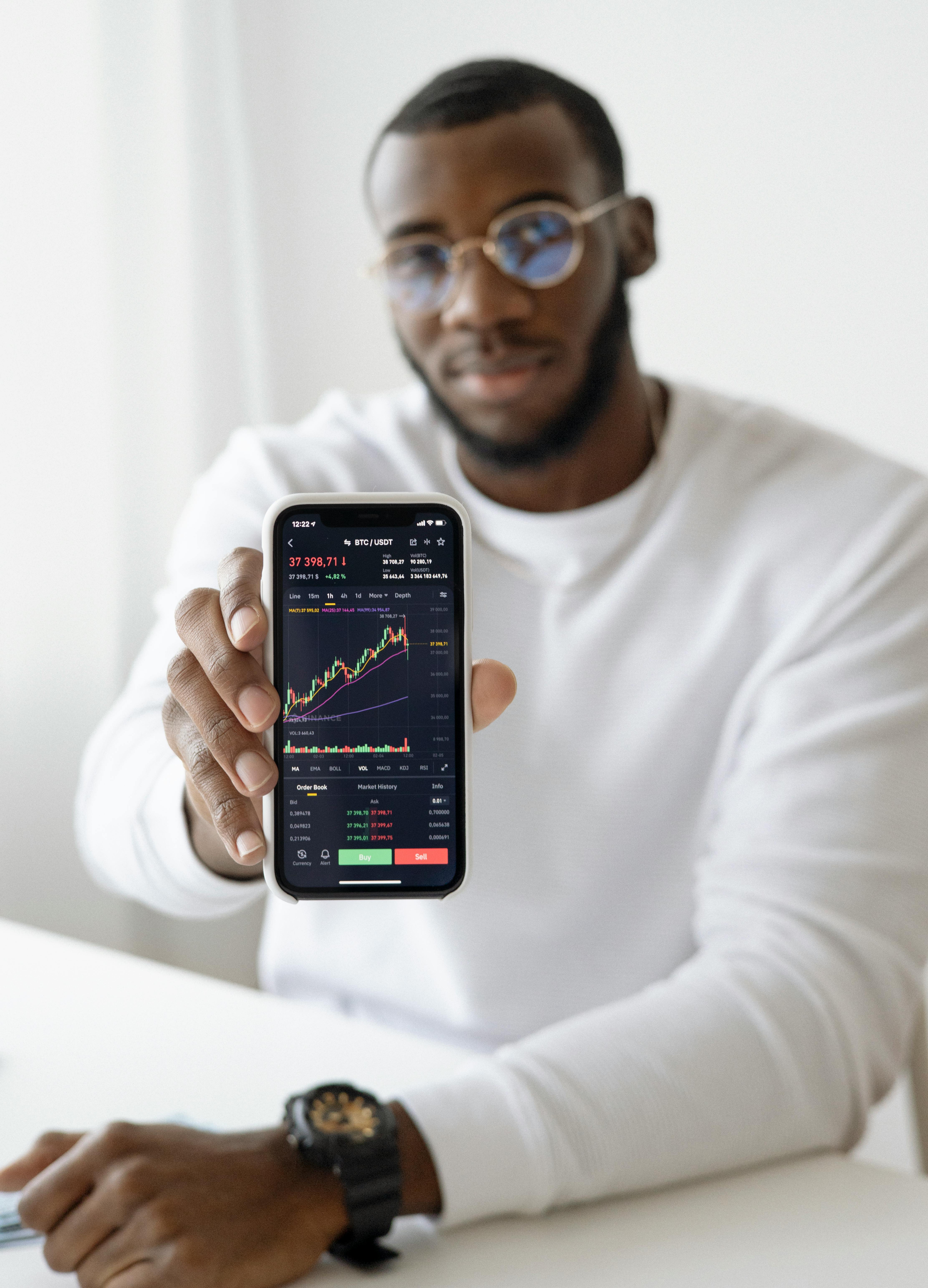Stocks Aren’t Just Shares — They’re Negotiations with Market Psychology (A Modern Investor’s Breakdown)
Stocks Aren’t Just Shares — They’re Negotiations with Market Psychology
Most new investors think buying stocks means purchasing a “piece of a company.” That’s technically correct — but strategically incomplete.
Stocks are not just ownership slices. They are psychological contracts between belief and reality — between what traders think a company will be worth and what it is actually producing right now.
That means every stock price is really a reflection of collective expectation — a crowd-driven guess dressed in numerical precision.

Stock Prices Aren’t Fixed — They Pulse With Collective Belief
If stocks were priced only based on company fundamentals, charts would look stable, predictable — almost boring. But real charts don’t look like that. They spike, collapse, surge, hesitate, explode — just like human emotion.
Here’s the real game: Owning a stock is not just owning equity — it’s participating in the emotional climate around that equity.
The investor who understands numbers and psychology navigates better than someone watching financial metrics alone.
📌 Markets don’t move when fundamentals change — they move when belief about fundamentals changes.
Every Stock Chart Tells a Psychological Story — Not Just a Financial One
Professional traders don’t just look at charts — they read emotion inside them. This is why two investors can see the same stock price but make completely opposite decisions.
Stocks move through three repeating emotional phases — regardless of the company, sector, or timeline:
The market panics over earnings rumors, sector news, or even unrelated macro headlines. Price dips quickly — not because value changed, but because collective fear collapsed confidence. Smart investors don’t rush — they observe the panic, waiting for exhaustion.
Price stabilizes. Volume decreases. Social media and forums stop mentioning the stock. 🧠 This is where silent professionals accumulate positions — not because hype is high, but because emotion is low and logic has room to breathe.
Suddenly, headlines reappear. Influencers mention the stock. Analysts “upgrade” it — right after institutional positions are already secured. Price climbs beyond fundamentals — not because of earnings, but because of FOMO momentum.

Real stock strategy: enter during quiet accumulation, not during noisy excitement.
There Are Three Types of Market Participants — Only One Consistently Wins
The stock market isn’t divided by capital size — it’s divided by behavior timing. It's not about how much money you trade — it’s about when you move relative to crowd emotion.
Here are the three classes that repeat across every market cycle:
| Class | Behavior Signature | Market Timing | Profit Outcome |
|---|---|---|---|
| 1. The Emotion-Driven Crowd | Buys on hype, sells on panic | Enters at peak excitement | Loses most of the time |
| 2. The Rational Analysts | Waits for price drop, attempts to enter logically | Tries to buy in correction phase | Medium success — often too late or too cautious |
| 3. The Accumulation Strategists | Act when the market is quiet and forgotten | Enter during emotional silence | Capture irrational upside before hype returns |
📌 Important Distinction: The market rewards timing against emotion — not timing against price.
Price tells you what happened. Emotion tells you what's coming. And the investor who listens to emotion — not opinion — enters when the crowd is silent, not when it's loud.

To win in stocks, you don’t need better analysis — you need better emotional timing.
Smart Investors Don’t Chase Price Levels — They Monitor Volatility Zones
Retail traders obsess over price points: “If it dips to $50, I’ll buy”. But professional investors rarely talk in fixed numbers. They watch volatility pockets — areas where price moves aggressively but volume doesn’t confirm direction.
Why? Because volatility without volume confirmation is a sign of market indecision — and indecision is the **cheapest phase** to accumulate positions.
📌 Volatility = Emotion Without Conviction. It's the moment where fear and greed collide — but neither side has taken full control yet.
This is where institutions quietly take positions — while retail traders argue online over whether the stock will “go up or crash.”

The Volatility Accumulation Framework — How Funds Enter Without Triggering Attention
Institutions follow a specific pattern when entering a stock — they never dump all capital at once. Instead, they drip-feed orders into volatility pockets to avoid alerting algorithms and retail scanners.
Here’s their basic logic:
| Volatility Signal | Retail Interpretation | Institutional Action |
|---|---|---|
| Sudden price spike with no news | “Something big coming? Should I chase?” | Small controlled entry to test reaction |
| Sharp drop on low volume | “It’s crashing! Panic sell!” | Quiet accumulation — because panic without volume = noise, not exit |
| Flat sideways motion | “Boring. I’ll look at hot stocks instead.” | Steady accumulation — best price-to-emotion ratio |
The highest returns rarely come from “big moves” — they come from silent accumulation inside volatility confusion.
The Market Doesn’t React to News — It Uses News to Justify Pre-Planned Moves
Retail investors wait for headlines. Institutional investors read order flow — long before any headline appears.
By the time news hits the public — price action has already positioned itself. This is why you often see a strange phenomenon:
- 📉 Stock drops hard hours or even days before “bad news” is officially released
- 📈 Stock rises even when earnings report shows weaker numbers than expected
- 😶 Market stays flat after a big announcement — because the move was already priced in
💡 News is not a trigger — it’s a narrative layer applied after movement to keep investors emotionally engaged.
Professional traders don’t wait for headlines. They watch how price reacts to silence.

Reading Price Reaction to Silence Is More Powerful Than Reacting to News
Here’s a powerful rule professional investors follow:
“Don’t ask what the news will do to the stock — ask what the stock is already doing while everyone waits for news.”
That’s because price action during silence reveals positioning. If volume increases quietly before earnings — someone is preparing. If the price compresses tightly instead of drifting — a release move is coming, regardless of the headline’s tone.
✅ Interpretation Framework:
- Price rises on no news → accumulation under silence → institutional interest
- Price falls but volume stays low → fake fear selling → retail panic without institutional exit
- Price stays flat with low volume before major event → ambush setup — big move incoming
📌 Side Note: This is why “waiting for confirmation candle after news” is one of the slowest — and most expensive — habits retail traders develop.
Real confirmation isn’t in headlines — it’s in how the market behaves before headlines arrive.
Professionals Enter Zones, Not Numbers — And That Changes Everything
Retail investors obsess over numbers: “I’ll buy at $42.50 exactly.” But professional traders don’t speak in fixed numbers — they speak in zones of emotional shift.
A Buy Zone is a range where:
- Price stabilizes after panic
- Volume slows down — not from lack of interest, but from controlled accumulation
- Market commentary stops — silence replaces hype
🎯 That silence is not decay — it's incubation. The moment the market forgets a stock, that’s when professionals start positioning.
Price numbers change — but zones of emotional exhaustion are universal. Once fear burns out, price stops collapsing. That floor is often invisible on financial reports, but it’s obvious on raw chart emotion.

The Real Entry Signal — Emotional Exhaustion, Not Price Discount
Here’s the truth no retail trading course explains:
Bargain prices don’t matter if emotion is still in panic phase — but even a higher price becomes a great entry if fear has already died.
Think of it like this:
- 📉 Cheap but still falling = emotional panic still active → avoid
- ⏳ Price stabilizing + low volume + silence = emotional exhaustion → ideal buy zone
- 📈 Sudden spike + hype returns = greed phase starting → too late
❗Important: You are not trying to “buy low” — you are trying to enter before belief returns. Because once belief returns, price rises irrationally — giving you a leverage window that fundamental analysis alone cannot predict.
In stocks, emotion always precedes price — and silence always precedes profit.
Forget Indicators — Price & Volume Already Reveal the Entire Emotional Landscape
Technical indicators are derived from price and volume — they never predict, they only summarize what already happened.
Professional investors skip the indicator layer and read directly from the source: Price Pulse + Volume Intensity.
Here’s a simple but powerful framework:
| Price Behavior | Volume Behavior | Emotional Signal Behind It |
|---|---|---|
| Sharp drop | High volume | Panic + mass exit (Not accumulation — stand back) |
| Sharp drop | Low volume | Retail fear without institutional exit (Potential accumulation zone forming) |
| Sideways movement | Low & steady volume | Emotion dead zone — prime zone for slow accumulation |
| Sudden spike | Very high volume | Late-entry greed — emotional blowout — exit or avoid entry |
📌 Key Insight: Indicators tell you what happened. Raw price and volume tell you what the crowd is feeling right now.
Volume Is Emotion Made Visible — Learn to Read It Like a Pulse
Think of volume as market heartbeat. It tells you when emotion rises and falls — even when price hasn’t reacted yet.
- 💔 High Volume + Flat Price → Hidden battle between accumulation and exit
- 🩺 Declining Volume + Stabilizing Price → Panic fading, calm entering → Accumulation readiness
- 🔥 Exploding Volume After Sideways → Breakout attempt — track direction, not headline justification
Volume is the emotional truth of the market. Price only shows the visible result of that emotion.
Professionals Never Say “We’re Bullish” — They Use Strategic Language to Conceal Entry
When hedge funds, asset managers, or institutional analysts speak publicly, they avoid signaling clear intent. Instead, they use what can be called “Accumulation Language” — phrases that sound neutral or even cautious, but actually hint that they are slowly entering a position.
Here are common examples of disguised accumulation phrasing:
| What They Say | How Retail Interprets It | What It Usually Means Internally |
|---|---|---|
| “We’re cautiously optimistic.” | Probably waiting — no urgency | They’re accumulating quietly at low volume |
| “We’re monitoring entry levels.” | Still undecided — I’ll wait too | They’ve already started position building |
| “It’s on our watchlist.” | Maybe they’ll buy someday | Watchlist = Early-stage accumulation phase |
| “Attractive levels for long-term evaluation.” | Sounds boring — move on | Code for: Our analysts approved accumulation |
🧠 Lesson: Professionals don’t declare their buying phase — they mask it beneath rational-sounding caution to prevent retail from following too early.
Media Commentary Is a Fog Layer — The Real Intent Is in Price Silence, Not Analyst Tone
TV analysts, finance blogs, and even official institutional commentary are designed to direct attention — not reveal positioning.
That’s why true professionals don’t watch financial news to get direction — they watch commentary to identify what narrative retail traders are being fed.
✅ Insight: If commentary is loud but price is flat — it means institutions are not buying with conviction. If commentary is quiet but price is stabilizing — accumulation is already happening under low noise.
The market speaks twice — once through media for emotion, and once through price for truth. Always listen to the second voice.
Professionals Never Announce Exit — They Shift Tone from “Potential Growth” to “Risk Evaluation”
Just like accumulation has a language, professional exit has its own coded vocabulary. Institutions never say: "We're selling now." — that would alert the crowd. Instead, they use soft psychological exit signals to begin unloading positions while retail interest is still rising.
Listen for phrases like these in financial commentary:
| What They Say | Retail Interpretation | What It Actually Means |
|---|---|---|
| “Valuation is getting ahead of fundamentals.” | Maybe it's too expensive — but still bullish? | Translation: We’re selling to those still chasing |
| “We’ve taken profits but still believe in long-term potential.” | They still believe, so I stay in | Translation: We already exited our heavy position |
| “Risk-reward balance is shifting.” | Sounds like a cautious warning | Translation: Uptrend is mostly over — unloading continues |
| “We’re reallocating into other opportunities.” | They’re bullish on other stuff | Translation: Exit underway, retail can take our place |
📌 Notice the pattern: The language shifts from optimism to “responsible repositioning”. That’s not risk management — that’s exit masking.
The True Exit Signal Isn’t Price Falling — It’s Volume Dropping While Price Holds High
Most retail investors think a sell-off starts when price falls. But institutions exit before price collapses — they unload into strong demand at the top.
How do you detect that?
- 📉 Price still climbing, but volume quietly decreasing = Exit pattern — large players selling slowly into late-entry buyers
- 🧊 Price holds high with flat movement = Liquidity distribution zone — the stock is being unloaded to retail without panic signals
- 🚨 Sudden heavy volume spike after slow distribution = Final blow-off — exit complete, next phase: retail trap
Watching volume at tops is more valuable than watching support at bottoms.
Professionals Don’t “Buy” — They Build Positions in Layers
Retail thinking: “I’ll wait for the perfect price, then I’ll go all in.” Professional thinking: “I will deploy capital in controlled fragments based on behavioral shifts, not price targets.”
This method is known as Layered Entry — a structured approach where the goal isn’t to buy cheap, but to buy intelligently through phases.
Here’s how a typical professional layer stack looks:
| Layer Stage | Market Emotion | Professional Action | Purpose |
|---|---|---|---|
| Layer 1 — Observation Entry | Market in fear or apathy | Small position to “ping” the market | Test emotional reaction |
| Layer 2 — Confirmation Add | Volume stabilizes, volatility cools | Add slightly higher amount | Lock early positioning before breakout |
| Layer 3 — Expansion Phase | Greed slowly returns | Add heavier position before news cycle | Exploit emotional shift for leverage |
| Layer 4 — Momentum Tail Add | Retail enthusiasm begins | Final scaling — not full confidence, just momentum ride | Capture irrational upside before exit phase |
✅ Why this works: Instead of praying for the perfect entry price, you evolve your position with the emotional cycle — entering when others are silent and expanding when sentiment begins to shift.
A professional doesn’t chase price — he synchronizes with emotion waves and builds accordingly.
Professionals Don’t Sell — They Extract Profit in Layers
Retail traders usually exit in one emotional blast — either out of fear (“It’s dropping — sell everything!”) or greed (“Take profits now before it reverses!”).
Hedge funds don’t do that. They don’t “sell” — they offload responsibility gradually back to the market using a method called Layered Exit Strategy.
Here’s how professional exit sequencing works:
| Exit Layer | Market Emotion Stage | Institutional Action | Objective |
|---|---|---|---|
| Layer 1 — Discreet Trim | Early optimism | Sell small portion into early retail excitement | Cover initial cost basis — risk neutral position |
| Layer 2 — Momentum Harvest | Excessive social media hype begins | Sell larger tranche while hype is building | Extract majority profit without signaling exit |
| Layer 3 — Retail Peak Transfer | FOMO spike / High volume retail inflow | Dump remaining shares just before blow-off top | Transfer final equity at irrational valuation levels |
✅ Note: Professionals leave some position open even near peak — not because they expect more upside, but to avoid signaling full exit in system reports. This is called a "residual placeholder" — a tactic that makes institutions appear still engaged to avoid algorithmic slippage during unload.
Retail exits emotionally. Institutional exits methodically — and invisibly.
You're Not Competing for Information — You're Competing for Timing Psychology
Most investors think success in the stock market is about “knowing more.” But the truth is simpler — the market doesn’t reward knowledge, it rewards timing against emotion.
All the fundamentals, all the technical analysis, all the headline watching — they are worthless if your emotional alignment remains synchronized with the crowd.
Winning in stocks = moving opposite to crowd emotion — but in sync with crowd fatigue.
That’s why professionals don’t hunt opportunities — they wait for emotional shift windows:
- 📉 Fear Exhaustion → Accumulation Window
- 📈 Greed Expansion → Profit Extraction Window
- 🔁 Silence Phase → Position Building Window
The entire stock market can be simplified into a rhythm of emotional windows. Once you see them, you stop thinking like a trader — you start operating like a timing strategist.
Authority References (SEO + Trust Signals)
These official financial bodies document liquidity behavior, institutional entry timing, and market psychology — perfect for linking at the end of a high-authority article:
- U.S. Securities and Exchange Commission (SEC) — Filing patterns reveal institutional accumulation timing.
- FINRA — Behavioral trading alerts used to detect emotional overreaction in retail markets.
- Federal Reserve Market Behavior Reports — Institutional liquidity modeling.
Stocks are not a guessing game — they are a timing conversation with crowd psychology. Enter when the market whispers, not when it screams.
